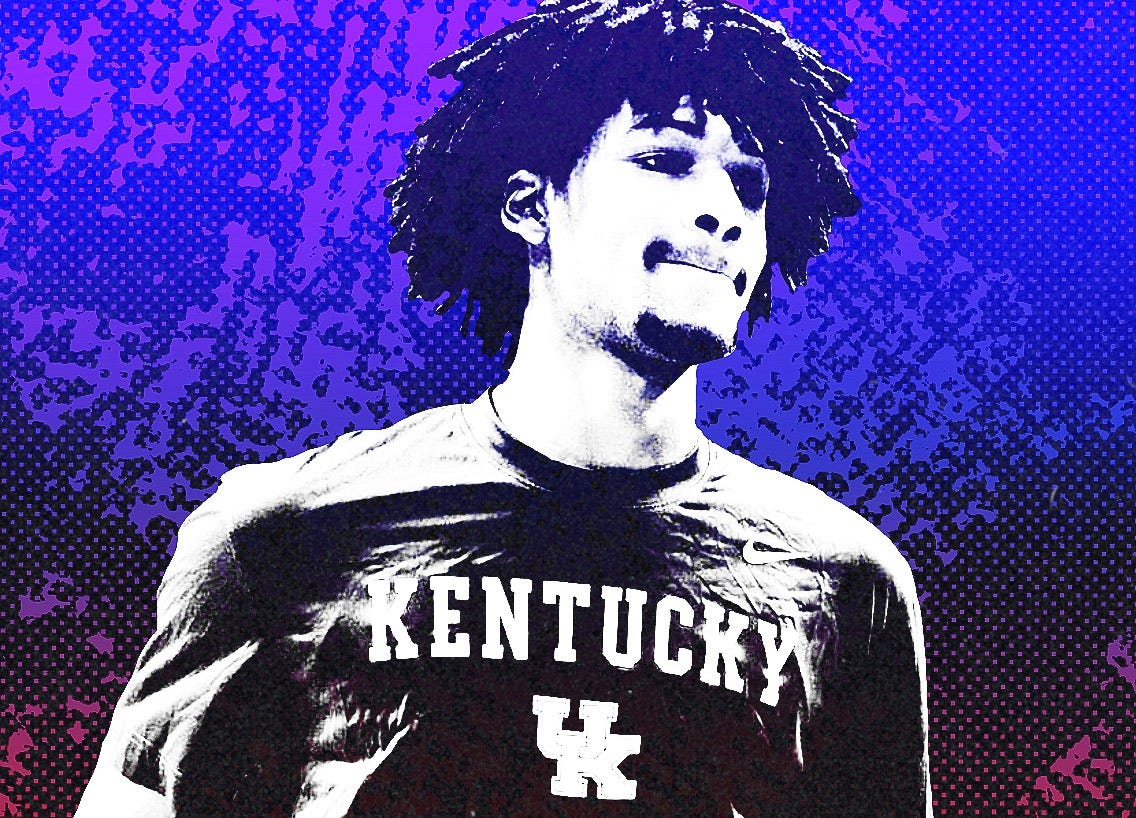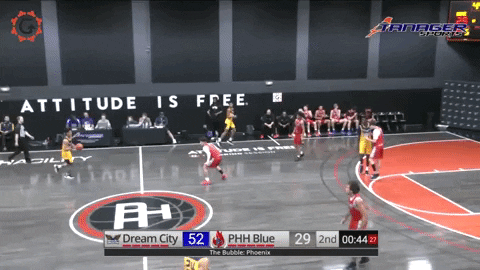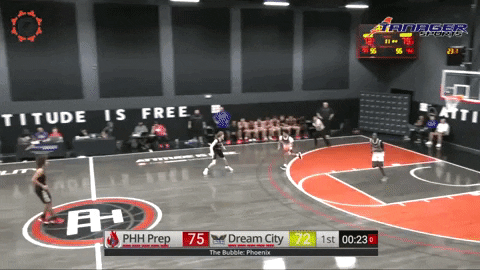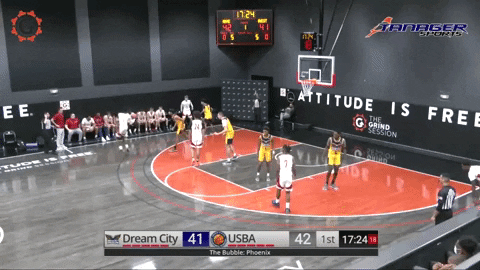Shaedon Sharpe: 2022's Mystery Man
Shaedon Sharpe is projected as a Top 10 pick in the 2022 NBA Draft despite having the least amount of available film and in-person scouting done on him. What can we expect?
There’s just something about the unknown that gets the people going.
When we look at talent acquisition, including drafting and trades, teams tend to engage in deals that involve picks as opposed to proven players (unless you’re the team acquiring the “star” in said swap).
Why is that? Why are packages for stars built around three to four first-round picks with contracts to make the money work instead of proven talent being the centerpiece(s) of the deal?
It’s the “mystery” of what those picks could become.
That’s why “tanking” is such a fascinating conversation around the league. It’s an accepted belief that the more draft picks you have, AKA “bites at the apple,” the better odds you have at landing a franchise-changing talent.
This same concept applies to actually using the pick. Is an organization more likely to take a player who has a more reasonable outcome yet not as high of a ceiling, or is it more practical to swing for the fences despite the inherent bust potential behind a player who is more of a work-in-progress?
Due to the NBA arguably having more talent than it ever has, the league is essentially an arms race. No longer can teams put one or two stars together, add some minimum contracts around those guys, and hope to waltz to The Finals.
Every roster spot is important. It’s not just about depth in a playoff series—it’s also about having the assets to cash in whenever a star becomes available on the open market. Finding the flexibility to operate in both the short and long term while racking up wins is a fine line few clubs actually walk well.
Part of that balancing act is drafting players with enough upside to develop into legitimate difference-makers, not just role players fighting for minutes near the end of a rotation in the postseason.
Contending for titles is what playing professional sports is all about at a macro level. There are plenty of financial and life benefits behind being a paid athlete in the best basketball league in the world, but the only way legacies are crafted in the eyes of many is with the rings to back it up.
And rings are won by blending the right amount of culture, discipline, and coaching with players who swing the scale in their team’s favor on both ends of the floor.
So who are some of the difference makers in this class? Chet Holmgren, Paolo Banchero, and Jabari Smith are the top names that come to mind.
There are also arguments for guards and wings, such as Jaden Ivey, AJ Griffin, Johnny Davis, and Bennedict Mathurin. Jalen Duren out of Memphis has been compared to Bam Adebayo.
Even Keegan Murray, albeit not the sexiest prospect, has what’s been perceived as an incredibly high floor that warrants exploring drafting him with a Top Five pick.
One name, however, has frustrated evaluators to no end over the course of the last few months: Kentucky’s Shaedon Sharpe.
Let’s get the most important point out of the way: Sharpe hasn’t even declared for the draft yet.
As far as most of us were aware, Sharpe chose to enroll early at Kentucky with the hopes of training with staff, practicing against his teammates, and getting acclimated to college life in hopes of better preparing himself for the 2022-23 season.
But this brings us back to the mystery conversation and why my opening monologue is relevant here.
Sharpe hasn’t played in any college games yet. He has the least amount of available film on him of any prospect currently being scouted for the 2022 draft. In-person viewings of Sharpe have also been walled off to NBA scouts and executives due to him being in high school.
So essentially, we have 12 games of Sharpe playing for Dream City Christian in Arizona to go off of, along with his time on the EYBL circuit and playing for Canada’s youth teams.
Is that enough of a sample size for high-level executives to draft Sharpe with the utmost certainty he’ll become a building block for a franchise? It’s a scary proposition, isn’t it?
BUT THAT’S THE THRILL!
For all that we don’t know about Sharpe, what we do know is that he fits the archetype of guard that teams covet. A 6’6” backcourt player who can play on and off the ball, shoot off the bounce from deep, finish above the rim, and (hopefully) defend multiple positions as his body fills out—all while possessing borderline elite athleticism in certain areas.
If that doesn’t get you fired up about what he could become in the NBA, then I can’t help you. I can still, however, try my best to show you and explain why I’m currently fighting to move Sharpe up my board and ahead of some of the more battle-tested prospects previously mentioned.
Let’s break down what I’ve really liked from my time watching Sharpe, and also touch on some areas he’ll have to clean up over time.
Offense
We’ll start with how he can break down defenders inside the arc in the halfcourt. Usually, when guards or wings with plus size and athletic advantages go up against their peers who aren’t as blessed in those areas, the offensive approach becomes too simple: bully to the basket, blow by, don’t think twice about who’s coming to help or where the rest of the team is.
Impressively, that’s not the extent of Shaedon Sharpe’s scoring package. Does he lack that elite first step to get past his man? Yes, we wouldn’t compare that initial burst of quickness to that of a Jalen Green, for example. But Sharpe sets himself up well and uses body fakes and a little dribble craft to pull off hesitation moves to get the defense off balance and get to the rack for the finish, or in this case, step back and swish the fallaway jumper.
Seeing well-executed footwork and patience in one-on-one situations is sometimes more encouraging to see from a young player. Even when we’re usually looking for those jaw-dropping displays of athleticism at the high school level to get us to buy in on pro potential, it’s a breath of fresh air when skill and substance are visible early on.
Trust me, however, there’s PLENTY of flash and flair to Sharpe’s game.
If you’ve watched even five minutes of Sharpe, then you’ve seen the heroics he pulls off in transition every time he’s on the floor. Forget about slowing him down in the open court. He leaks out early, fills the lane well, and can sky off two feet and throw down the hammer.
When the ball is in his hands, it’s difficult to stop and contain him before he gets his feet in the paint. And when he gets there, he has the nifty scoops and a saucy layup package to get the job done even when he has to contort his body or alter his shot.
The pick-and-roll game, though, is really where Sharpe could use the most polish offensively.
As far as being a primary decision-maker in the halfcourt, one can tell he’s still learning how to read through multiple progressions, time his moves, and play his angles correctly off an initial screen up top.
This is where not having that immediate blow-by speed is a little bit of an issue. If Sharpe doesn’t take the right angle off his first move, he puts himself in a position to be walled off by the defense and potentially stuck in no man’s land.
To Sharpe’s credit, he has some of those counters you would look for to avoid turnovers in those spots, and he does have the awareness to even pull his dribble back out and reset.
I’m a sucker for guys who know when to admit defeat on a drive or play and make the right decision to come back out or pass to someone else.
Where’s he’s most lethal is pulling up out of pick-and-roll and the range he has to pull the trigger from, especially if his man doesn’t fight over the top. While one can argue Sharpe settles for too many of these and can get a little comfortable, there’s a reason why the deadliest guard scorers are those who can pull up off a screen.
And when he has the jumper going, it sets up what he can do off the drive, and catching bodies isn’t only reserved for when he’s skying in transition.
As for passing out of those actions, he gets the job done if the initial read is there for him. Sharpe can make the easy pocket pass to the open roller or the kickout to the corner shooter, depending on his angle of attack.
What I wouldn’t expect to see from Sharpe anytime soon is cross-court feeds, wrap-around dishes, or too many lobs. I can tell the game already moves at a good pace for him, and making some of those passes gets exponentially harder in the NBA because of the reaction time of quicker, longer defenders. Then factor in how wired Sharpe is to score or shoot off of those actions as it is, and it’s clear he’s set up to score first, pass second because of how natural his pull-up is to him.
Telegraphing passes is never the key to success either, and I’ve seen Sharpe do that on a number of simple deliveries. Mixing in some of that deception he has one-on-one when he accepts the screen and drives into the teeth of the defense takes a ton of practice and patience, not to mention mastery of start-stop and a slick handle. Sharpe’s command is decent, and he controls his body well, but peeling the onion back and seeing all the layers of the defense is the next step for him to better show more of what he can do in the halfcourt.
What really sets him apart, though, besides his knack for getting easy buckets on the break, is his pull-up shooting from distance.
His three-point game is incredibly advanced for a player his age and may explain why he’s not as developed as a passer and playmaker in traffic as his talent suggests. When a player can either commit to driving and facing punishment from the defense in the lane or pull up from the parking lot and drop in a triple, which do you think is the easier decision to make?
Distance shooting is an incredible equalizer, and the smooth mechanics and comfort level firing off the bounce, off the catch, or stopping and popping in transition is awesome to see from a player his age. And given where the NBA is going, I would expect this part of his skill set to carry over and serve him well at the next level.
This shouldn’t stop his pull-up game inside the arc from reaching new heights, though. Yes, Sharpe has the touch as a finisher, and he should be able to develop a nice floater to complement the other parts of his game (which he’ll need if he doesn’t improve finishing through the defense, not just around or over).
But right now, he’s really more of a one-and-a-half level scorer instead of a three-level bucket getter. The stars in the league are the guys who can get their shot from anywhere at any time, and that includes step-backs and smooth pull-ups off two dribbles.
Sharpe can play North-South right now, but figuring out how to play East-West will be the next step for him, and that will mean getting out of his comfort zone, only scoring in transition or off three-point looks.
I sound like I have real concerns about how dynamic of an on-ball offensive threat he is, and to some extent, that’s true. But what I also talked about as far as the shiftiness to his game, shooting form, two-foot leaping ability, and comfort level converting from distance point to an upside that’s difficult for a ton of players to reach. He’s ultimately better suited in the short term to be more of an off-ball talent, but I have full confidence he’ll get better at analyzing the defense and picking teams apart with the ball in his hands.
Some things just take time, but the rest of Sharpe’s offensive package will be worth the wait.
Defense
There are certain things I could bring to light about Shaedon Sharpe’s defense, but I’m choosing not to.
Honestly, a lot of guards are not good defensively before and even during their time in the NBA. Playing on the perimeter is harder than ever with the number of three-point shots that are constantly being launched.
Better athletes with size who can penetrate at will are acting as lead ball handlers so often in today’s league, leading to difficult decisions made by NBA defenders every trip down the floor. Collapse and help, and it’s an easy kickout or swing to an open shooter should the defense not recover quick enough on the closeout. Stay home and refuse to help, and guys like Luka Doncic, James Harden, and the list goes on and on carve up their matchups one-on-one and either draw the foul or finish through contact.
This is what makes point-of-attack defense so critical at higher levels. And that requires an incredible amount of discipline, along with being quick enough laterally, having the appropriate length and quick hands to make a play on the ball, and the physical strength to body up and not get bowled over.
How many guys in the league are truly elite at this area on defense? The answer is very few.
Which is why defense for the vast majority of players comes down to execution within a team’s system and communication. Learning how a team operates on switches, callouts, matchups, etc., sometimes takes years of experience, let alone simple chemistry.
How is a rookie supposed to manage all of that when they aren’t physically developed and moving up to play at a level where the game moves so fast because it’s the best of the best making every decision at light speed with the ball on a string?
That’s why I’ve stopped setting high expectations when evaluating young prospects on this end of the floor. What I want to take notice to are: does the prospect have the measurables as a base, and from there, do they sit in a stance, show discipline and the WILLINGNESS and EFFORT to guard and contest?
I can say that Sharpe, to my eye, wins half the battle. He gets back and contests in transition, plays passing lanes, and has the size and length to guard either position in the backcourt.
Is he the most aware of everything that’s going on around him at all times? No. Does he gamble a little too much on plays he shouldn’t? And when he does try to play to that style of defense, does he at least play the right angle to put himself in position to make a play if he’s beat poorly off the bounce?
That’s a no from me as well.
I do have questions regarding Sharpe just looking bored out there at times. Sure there are examples where he plays “hero ball” and makes a play to get out in transition, but there are double the number of clips where he’s ball watching or simply misses what’s going on.
With the right coaching and patience, it’s my feeling he has the TOOLS to be an above-average defender in the NBA. Getting there and developing the communication and chemistry with his teammates is an entirely different story.
One has every right to have doubts regarding Sharpe’s defensive ceiling after watching the tape. It’s also not something that should be a full representation of what he could be on that end four to five years from now.
As Jake Rosen said on the No Ceilings podcast, “you’re not drafting Sharpe to be a difference-maker on defense.”
Overall Outlook
The things I’ve outlined for Shaedon Sharpe to work on are common flaws amongst prospects.
But the “unknown” that exists with Sharpe lies in the star potential he brings to the table because of some of his outlier characteristics.
Plus positional size, lethal range, and shooting ability, elite transition play, and the makings of a legit combo guard all point to a pretty remarkable ceiling for Sharpe, even if some of the flaws may hold him back from getting there within his first few years in the league.
Adjusting to a new level of play while also figuring out how to do more with more responsibility will be a tall order for the potential rookie.
Betting on talent, however, is what wins championships in the NBA. I’ll gladly take the upside swing on the player who has a chance to develop into an explosive offensive talent while holding his own defensively.
And given some of the concerns that other top targets have after the consensus three forwards and Ivey, one can make a very reasonable case to consider Sharpe as the next-best available.
When guys have all of the film to nitpick and tear apart, it’s easy to talk yourself out of that talent.
And once that happens, it’s easy to buy into the intrigue and enigma of one Mr. Sharpe.
Consider me as that guy who would take the swing and buy the dip.














Acts 16:31, 1 Corinthians 15:1-8, 1 Peter 1:17-21, Revelation 22:18-19